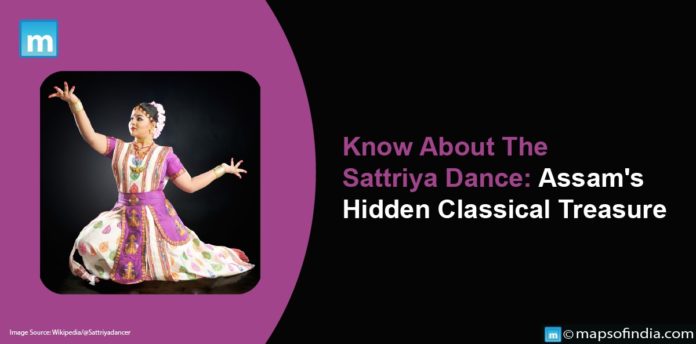Sattriya occupies a unique and distinguished place in the vibrant tapestry of Indian classical dance forms. This captivating dance form evolved over centuries in Assam monasteries, blending spiritual devotion with intricate movements and compelling storytelling. Despite its rich heritage and artistic brilliance, Sattriya, also known as India’s hidden classical treasure, is relatively unknown outside of Assam.
Historical Roots
Sattriya dance originated in the Vaishnavite monasteries or “Sattras” of Assam. These sattras, founded in the 15th century by the revered saint and cultural icon Srimanta Sankardev, played a critical role in preserving and promoting Assamese art and culture. The dance form began as a part of religious rituals and celebrations within the sattras before evolving into a classical art form.
Unique Characteristics
Sattriya dance is distinguished by its graceful movements, subtle expressions, and colorful costumes. It combines elements of dance and drama, making it a comprehensive and engaging form of artistic expression. Sattriya’s repertoire includes several dance sequences, each with its distinct style and narrative. The dance form encompasses many emotions, from the serene and holy to the energetic and celebratory.
Sattriya’s use of traditional Assamese music, dominated by instruments such as the khol (drum), taal (cymbals), and flute, is one of its distinguishing features. This music’s rhythmic patterns and melodic structures add a distinct flavor to the dance, creating a sensory experience that resonates with Assam’s cultural ethos.
Costumes and Ornaments
Sattriya dancers’ costumes and ornaments are a visual feast in and of themselves. Female dancers typically wear the indigenous Assamese Muga silk costume. The clothing’s intricate designs and vibrant colors reflect the region’s rich textile heritage. Elaborate jewelry, such as the matha-kharu (head ornament), galpata (neckpiece), and kanchi (bracelets), add to the performance’s overall aesthetic appeal.
Themes and Narratives
Sattriya dance is frequently inspired by Assamese mythology and folklore. The dance narratives are based on stories from the great epics such as the Ramayana and the Mahabharata, as well as stories from Lord Krishna’s life. The performances are more than just a display of skill and technique; they are a journey into Assam’s cultural and spiritual roots.
Sattriya dance becomes a medium for preserving and passing down Assamese cultural heritage through storytelling. It links the region’s ancient traditions and the modern world, ensuring that the stories and values embedded in the dance form remain alive and relevant.
Recognition and Revival
While Sattriya dance has deep roots in Assam, it only recently gained national recognition. The Sangeet Natak Akademi, India’s premier cultural institution, officially recognized the Sattriya dance form as one of the country’s eight classical dance forms 2000. This recognition elevated Sattriya’s status and provided opportunities for its promotion and preservation.
Attempts have been made within and outside Assam to revive and popularize Sattriya. Sattriya has been introduced to a broader audience through dance festivals, workshops, and collaborations with other classical dance forms. Notable dancers and gurus have devoted their lives to spreading this exquisite dance form, ensuring it receives the attention and appreciation it deserves.
Sattriya dance is an example of the rich cultural diversity that characterizes India. The classical dance form, rooted in Assamese spiritual and artistic traditions, is a treasure waiting to be discovered by a wider audience. Sattriya is a captivating experience that transcends time and geography thanks to its graceful movements, evocative storytelling, and vibrant aesthetics.




